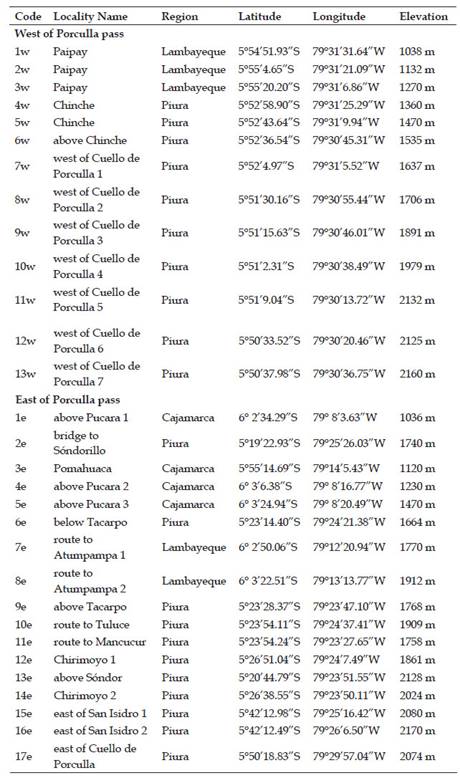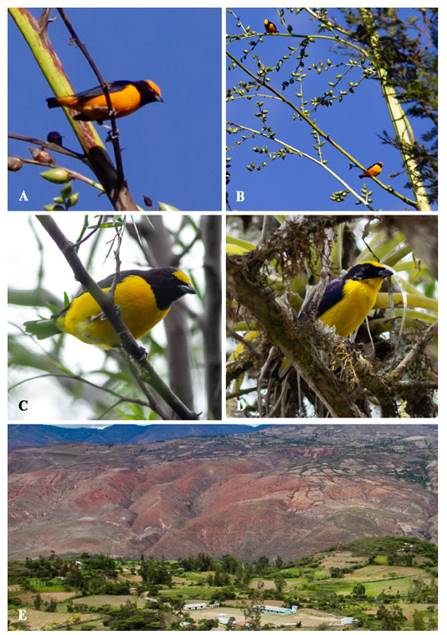Introduction
The seasonally dry tropical forest (SDTF) of the southwest of Ecuador and northwest of Peru (Equatorial SDTF) has an outstanding level of endemicity and is a critically important hotspot of biodiversity in the world (Linares-Palomino, Kvist, Aguirre-Mendoza, et al., 2010; Myers, Mittermeier, Mittermeier, et al., 2000; Singh & Chaturvedi, 2018)5-6 dry months within the annual cycle, and nutrient-poor soil. Several terms have been used for this vegetation type such as seasonally dry tropical forest (SDTF. This uniqueness in the biodiversity is the result of a variety of habitats, ranging from the arid coastal plains to the montane dry forest formations on the Andean slopes (Marcelo-Peña, Huamantupa, Särkinen, et al., 2016; Singh & Chaturvedi, 2018)5-6 dry months within the annual cycle, and nutrient-poor soil. Several terms have been used for this vegetation type such as seasonally dry tropical forest (SDTF. The partially synchronous uplift process of the northern and the central Andean chains produced the separation of the Equatorial SDTF into two well-defined biogeographic units: the Tumbes/Piura dry forest ecoregion, on the western side of the Andes, and the Marañón valley dry forests ecoregion, on the eastern side of the Andes (Cadena, Pedraza, & Brumfield, 2016; Hoorn, Wesselingh, Steege, et al., 2010; Oswald, Overcast, Mauck, et al., 2017). Nowadays, Porculla pass, at 2145 m in the northwest of Peru, is the lowest point of this geographical division (Linares-Palomino, 2006; Linares-Palomino, Pennington, & Bridgewater, 2003; Weigend, 2002).
In terms of endemism, in the same way as with the ecoregions, the western and eastern side of the Porculla pass belong to a different endemic bird area (EBA): the Tumbesian Region (EBA 045) and the Marañón Valley (EBA 048), respectively (BirdLife International, 2019b, 2019a). Globally, very few EBAs have the same amount of restricted-range bird species as the Tumbesian Region (55 species) and the Marañón Valley (22 species) (BirdLife International, 2019b, 2019a; Ugaz & Saldaña, 2014). However, the survival of these birds are worryingly supported by small fragments of dry forests and scrub remaining in the area, mainly on inaccessible slopes since most of the natural vegetation has been destroyed by human activities for farmland and livestock (Best & Kessler, 1995; Parker, Schulenberg, Graves, et al., 1985).
The topographic complexity and the access difficulty are responsible for the poor attention this area has received. The last scientific report about the avian diversity of this area has been published 35 years ago by Parker, Schulenberg, Graves, & Braun (1985), who recorded 42 species in the desert scrub northeast of Huancabamba city. To date, no extensive work about the birds of the rest of the Huancabamba- Chamaya system nor the western side of the Porculla pass has been published. Our goal was to update the checklist of bird species associated with this area, with a special emphasis on the Huancabamba- Chamaya river sub-basin. Additionally, our noteworthy records of trans-Andean bird taxa suggest that exhaustive fieldwork will continue to produce discoveries concerning the distribution and biogeography of the Tumbes-Piura and Marañón valley dry- forest avifauna, and they could give us a better understanding of the interactions between the restricted-range bird species whose populations co-occur on the east side of the Porculla pass.
Materials and methods
Study area
Porculla pass area lies on the north of Peru, between the regions of Piura, Lambayeque, and Cajamarca. This mountain pass has its lowest point at 2145 m in “Cuello de Porculla town” at 5°50’25.26”S, 79°30’21.71”W, Piura region (Figure 1). The western side has uniform open valleys and dense vegetation associated with Tumbes- Piura dry forest ecoregion (Figure 1b). It is dominated by semi-deciduous species at lower elevations, such as Eriotheca discolor, Ceiba trichistandra, Bursera graveolens, and Loxopterigium huasango, as well as a more mixed and diverse forest at higher elevations, including species such as Ocotea cernua and Myrcianthes discolor (Rasal Sánchez et al. 2011, Ceroni Stuva 2003, I.S.S personal observation). The upper part of the Porculla pass contains some patches of transitional habitat from cloud forest to dense montane scrub, with species such as Oreocallis grandiflora. The eastern side streams create the Huancabamba-Chamaya river sub-basin, which is the westernmost tributary of Marañón river in Peru. This side is eroded and arid, with sandstone and limestone sequences characteristic of Marañón valley tributaries (Figure 1b, Marcelo-Peña et al. 2016). The vegetation, dominated by Acacia macracantha, is quite scattered, even more opened as one descends the elevational gradient.
Bird surveys
Since 2014, the Maria Koepcke Lab of Ornithology from the Peruvian NGO CINBIOTYC (Spanish initial of “Centro de Investigación en Biología Tropical y Conservación”), has been investigating the bird diversity in ecosystems of Tumbes, Piura, Lambayeque, Cajamarca and La Libertad regions with the self-financed project Bird Assessments in Ecosystems of the Northwest of Peru (unpublished data). The project’s goal is to compile and update the information about the distribution of the bird species of northwestern Peru, involving thesis projects, short communications and scientific articles highlighting their field observations. Here we present the presence- only data of 30 georeferenced localities between 1000 to 2200 m on both sides of Porculla pass (Figure 1), obtained between August 2014 to October 2018.
The data collection followed the same methodology in all the localities surveyed: two line-transects of 500 m long per locality with two visits on most of them (n=20), with a total effort of 50 line-transects, which represent 25 km walked. The evaluations were mainly performed early in the morning or before sunset (5:00-10:00 and 15:00-18:00 hrs). The bird species were identified to subspecies level when it was possible, following the official taxonomy for South American Classification Committee (SACC; Remsen, Areta, Cadena, et al., 2019) and the descriptions published in the literature (Angulo, Palomino, Arnal-Delgado, et al., 2008; del Hoyo, Elliott, Sargatal, et al., 2018; Schulenberg, Stotz, Lane, et al., 2010; Ugaz & Saldaña, 2014).
Species accounts
We recorded 170 bird taxa (including species and subspecies reported), belonging to 163 species and 32 families (Table 2). All the species were residents, except for two migratory species, one boreal migratory Black-billed Cuckoo (Coccyzus erythropthalmus), and one austral migratory Slaty Thrush (Turdus nigriceps). Likewise, we reported one vagrant species Orange- crowned Euphonia ( Euphonia saturata¸ Figure 11 A,B) on the east side of the Porculla pass.
The bird species richness was greater on the western side (144 species) than on the eastern side (121 species) of Porculla pass. We reported four endemic species of Peru and 29 restricted-range species, from which five are restricted to Marañón Valley EBA, 25 to Tumbesian Region EBA, and one is shared between them (Grey-breasted Flycatcher Lathrotriccus griseipectus; Figure 5E). Ten species belonging to the IUCN’s red list of threatened species, one Endangered (EN), six Vulnerable (VU), and three Near Threatened (NT; Table 2). We obtained four previously undocumented new records of trans-Andean birds, all of them on the eastern side of the Andes in Huancabamba-Chamaya river sub- basin: Amazilia Hummingbird Amazilia amazilia leucophoea (Figure 2D), Orange- crowned Euphonia Euphonia saturata (Figure 11A,B), Three-banded Warbler Basileuterus trifasciatus and Common Vermilion Flycatcher Pyrocephalus rubinus piurae (Figure 6 A,B; Table 2). Besides, two records were removed from the original checklists due to the lack of evidence to prove them, remaining as hypothetical (not confirmed nor documented) observations to the eastern side of the Porculla pass in the Huancabamba-Chamaya river sub-basin (Maranon Sparrow Arremon abeillei nigriceps and Maranon Crescentchest Melanopareia maranonica). We will discuss our remarkable observations in the following paragraphs.

Fig. 2 A. Metriopelia ceciliae (east); B. Patagioenas oenops; C. Amazilia franciae (male); D. Amazilia amazilia leucophaea (east); E. Chaetocercus mulsant (female, east); F. Heliomaster longirostris.
Ochre-bellied Dove Leptotila ochraceiventris
ISS and AB observed an individual walking through the undergrowth, and heard another 30 min later in understory at 1500 m, route to Cuello de Porculla town - Piura region, on 13 June 2016. AU and ABC heard another individual in the same locality, on 28 March 2018. This species has been largely confined to the zone at 500- 1800 m due to habitat deforestation. Records of this species are uncommon due to their low abundance in most of their distribution range (Schulenberg et al., 2010). However, its vocalizations are quite distinctive, it is difficult to mistake for L. verrauxi (del Hoyo, Elliott, Sargatal, et al., 2019).
Peruvian Pigeon Patagioenas oenops
This Marañón valley endemic has been overlooked in the Huancabamba-Chamaya river sub-basin. ISS made an opportunistic record of an individual perching in a Eucalyptus sp. tree out of the study area, at 2450 m on the Huancabamba-Canchaque route - Piura region (-5.271753°S -79.472275°W), on 20 July 2017. This record was confirmed later when ISS, DAB, and AB observed and photographed two individuals at 1750 m near Chirimoyo town- Piura region, on 17 May 2018 (Figure 2B). Our records represent the westernmost ones and determine that the species has not been extirped from the area as BirdLife International (2018) states.
Black-billed Cuckoo Coccyzus erythropthalmus
ISS observed on 18 March 2017 an individual flying over a relict forest of Acacia macracantha, at 1750 m on the route Sóndor- Sóndorillo - Piura region. Although this common species is widely distributed in Peru during its migration (del Hoyo, Elliott, et al., 2019; Schulenberg et al., 2010), this is the first confirmed record in dry habitats of Marañón valley.
Gray-chinned Hermit Phaethornis griseogularis
Several observations by ISS, RBG, ABC, and AU between 1250 and 1948 m, mainly in the dense understory on the western side of the Porculla Pass. ISS photographed an adult in understory next to a trail above Pucará - Cajamarca region, on 22 March 2017 (Figure 3C). Frequently subordinated by other hummingbirds. It was more common in lower areas of the Pacific slope. This species is distributed between Loja province -Ecuador and Lambayeque region - Peru. The record of P. griseogularis on the eastern slope require more evidence to elucidate the which subspecies - P. g. porcullae o P. g. zonura - occur there.
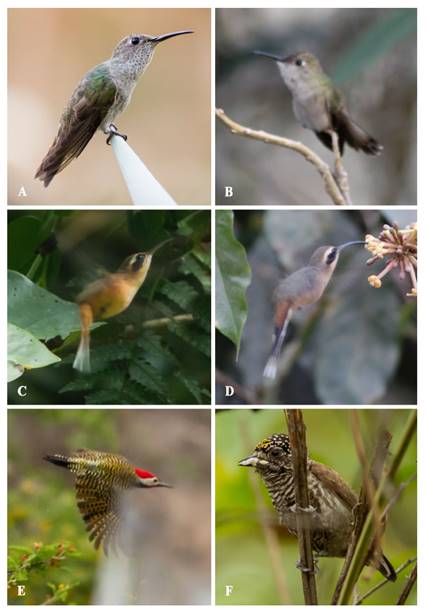
Fig. 3 A. Thaumasius taczanowskii (endemic); B. Thaumasius baeri; C. Phaethornis griseogularis (east slope); D. Phaethornis griseogularis (west slope); E. Colaptes atricollis peruvianus (endemic); F. Picumnus sclateri (male).
Amazilia Hummingbird Amazilia amazilia leucophoea
Fairly common in most of the surveyed areas. Frequently observed on the east side of the Porculla pass, e.g., Chirimoyo - Piura region at 1750m (Figure 2D) or Pomahuaca - Cajamarca region at 1100 m. This is the first documented trans-Andean record the Amazilia Hummingbird (Schulenberg et al., 2010; Weller, 2000), despite it has already been observed in other areas of the Marañón valley in numerous occasions between 800-2650 m (ISS and LMV, personal communication).
Collared Antshrike Thamnophilus bernardi
ISS photographed a male juvenile (Figure 4E) moving between Acacia macracantha relicts at 1733 m, Tacarpo - Piura region, on 9 August 2014. Despite the lack of evidence to determine which subspecies of T. bernardi occur on the eastern slope of the Porculla Pass, this record is interesting because on either case it could clarify the trans-Andean status of western T. b. bernari, or it could represent the westernmost record of the less-known, Marañón endemic subspecies T. b. shumbae (del Hoyo, Collar, & Kirwan, 2019). There is necessary to perform more detailed fieldwork to demonstrate which is the case here.

Fig. 4 A. Pardirallus sanguinolentus (juvenile); B. Falco femoralis; C. Forpus coelestis (female); D. Thamnophilus zarumae; E. Thamnophilus bernardi (female); F. Thamnophilus bernardi (male).
Short-tailed Field-tyrant Muscigralla brevicauda
Common in open habitats in lowland and arid inter-Andean valleys (del Hoyo, Elliott, et al., 2019; Schulenberg et al., 2010; Ugaz & Saldaña, 2014). The trans- Andean status of the Short-tailed Field- tyrant has been previously documented in the literature, with several records in the Marañón Valley in Jaén vicinity - Cajamarca region, up to 1200 - 1500 m (del Hoyo, Elliott, et al., 2019; Schulenberg et al., 2010; Sullivan, Wood, Iliff, et al., 2009). ISS photographed this species at 1670 m at Tacarpo - Piura region (Figure 5B) and observed many others inhabiting the dry scrubland and open areas of Huancabamba- Chamaya river sub-basin up to 1750 m.

Fig. 5 A. Melanopareia elegans (male); B. Muscigralla brevicauda (east); C. Agriornis montana; D. Myiopagis subplacens; E. Lathrotriccus griseipectus; F. Anairetes flavirostris.
Piura Chat-Tyrant Ochthoeca piurae (endemic)
One individual observed perching and flying over the bushes at 2125 m on the west side of the Cuello de Porculla town - Piura region, on 12 June 2016 (Figure 6C). This locality is one of the northernmost areas where the species has been regularly recorded (Farnsworth & Langham, 2019).

Fig. 6 A. Pyrocephalus rubinus piurae (east slope, male); B. Pyrocephalus rubinus piurae (east slope, female); C. Ochthoeca piurae (endemic); D. Contopus punensis; E. Pachyramphus spodiurus (male); F. Pachyramphus homochrous (male).

Fig. 7 A. Cyanocorax mystacalis; B. Pheugopedius sclateri paucimaculatus; C. Polioptila plumbea maior (east slope, male); D. Polioptila plumbea maior (east slope, female); E. Polioptila plumbea bilineata (male); F. Polioptila plumbea bilineata (female).
Vermilion Flycatcher Pyrocephalus rubinus piurae
This subspecies is supposed to be replaced by P. rubinus ardens in areas of the Marañón river basin (Farnsworth, Lebbin, & Kirwan, 2019). Our records show that the subspecies piurae occurs on the eastern side of the Porculla Pass. All the females that we have observed on the Huancabamba- Chamaya river sub-basin have the pale plumage of piurae (Figure 6B) instead of the brighter orange tones on belly and crown that ardens has (Farnsworth et al., 2019; Schulenberg et al., 2010).
Slaty Becard Pachyramphus spodiurus
This Tumbesian Region’s endemic is rather uncommon, very local, and probably often overlooked. Its forest habitat has been nearly destroyed, and severely fragmented as a result of timber extraction and livestock grazing (del Hoyo, Elliott, et al., 2019). AU photographed an adult male at 1026 m (Figure 2) above Paipay - Lambayeque region, on 21 March 2017 (Figure 6E). This represents a new locality, in addition to the other approximately 29 to 31 previously known in its fragmented distributional range (Best & Kessler, 1995; del Hoyo, Elliott, et al., 2019; IUCN, 2019; Parker et al., 1985).
Maranon Thrush Turdus maranonicus
ISS and AU observed and photographed an individual on two occasions at 1036 m near Pucará - Cajamarca region, on 11 April 2015 (Figure 8D), where it appears to be uncommon. ISS observed one in flight at the same locality the next day. This species is fairly common in forested lower areas of Marañón valley (del Hoyo, Elliott, et al., 2019).

Fig. 8 A. Cyclarhis gujanensis saturata/contrerasi; B. Cyclarhis gujanensis virenticeps; C. Turdus reevei; D. Turdus maranonicus; E. Coereba flaveola magnirostris; F. Incaspiza ortizi (endemic).
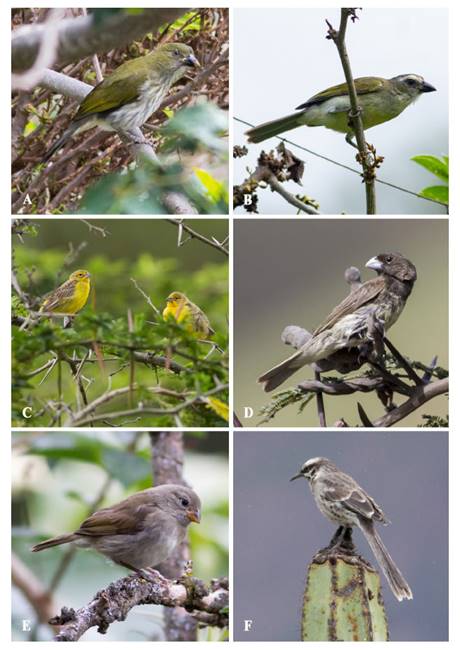
Fig. 9 A. Saltator striatipectus peruvianus; B. Saltator striatipectus immaculatus; C. Sicalis luteola; D. Sporophila nigricollis (male); E. Asemospiza obscura; F. Mimus longicaudatus (east).
Grey-winged Inca-finch Incaspiza ortizi (endemic)
Two individuals observed and photographed by ISS at 2170 m on the Sóndor-Tabaconas highway - Piura region, on 19 May 2016 (Figure 8F), and an individual photographed on 18 April 2018 in the same locality. These records confirm the documented record of Parker et al. (1985) and the unpublished record of F. Angulo from June of 2014 (Sullivan et al., 2009). The scrub and natural dry bushes of the area have been severely degraded and burned, however, the species persists. Unfortunately, we did not find other locations for this species in the Huancamaba-Chamaya river sub-basin, on the east slope of the Porculla Pass.
Three-banded Warbler Basileuterus trifasciatus
ISS photographed an adult at 1700 m near Tacarpo - Piura region, on 18 May 2016. Likewise, a flock of four Three- banded Warbler, one photographed by ISS, observed among the bushes at 1750m below Chirimoyo - Piura region, on 14 April 2018 (Figure 10E). These are the first documented records of this species on the eastern slope of the Andes, where is widely replaced by B. tristriatus, but only in more humid habitats. The Three-banded Warbler inhabits dense vegetation in dry forests, riparian thickets, shrubby forest clearings, and well-developed second growth with dense undergrowth, mainly at 500-2000 m (Curson, 2019).
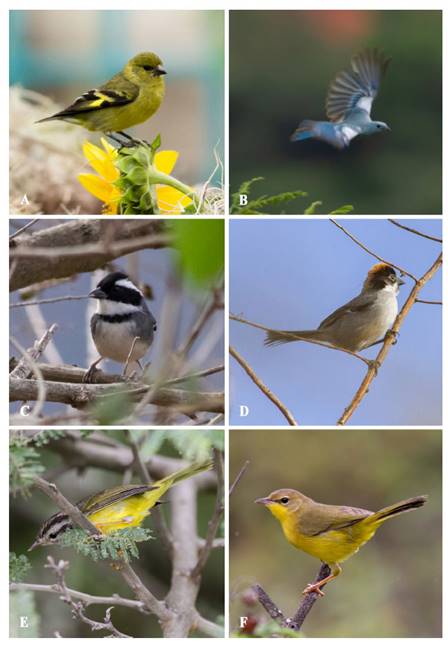
Fig. 10 A. Spinus magellanicus; B. Tangara episcopus caerulea; C. Arremon abeillei; D. Atlapetes leucopterus dresseri; E. Basileuterus trifasciatus (east); F. Geothlypis auricularis (east).
Orange-crowned Euphonia Euphonia saturata
ISS observed two males foraging on an inflorescence of Agave americana at 1742 m near to Tacarpo - Piura region, on 18 May 2016 (Figure 11A,B). Our observation is the first documented trans-Andean record, as well as, the highest in Peru (Schulenberg et al., 2010), extending its distribution 170 km to the southeast and 1000 m above from its previously known range, in the limit between Ecuador and Peru (Hilty, 2018; Schulenberg et al., 2010).












 uBio
uBio 


